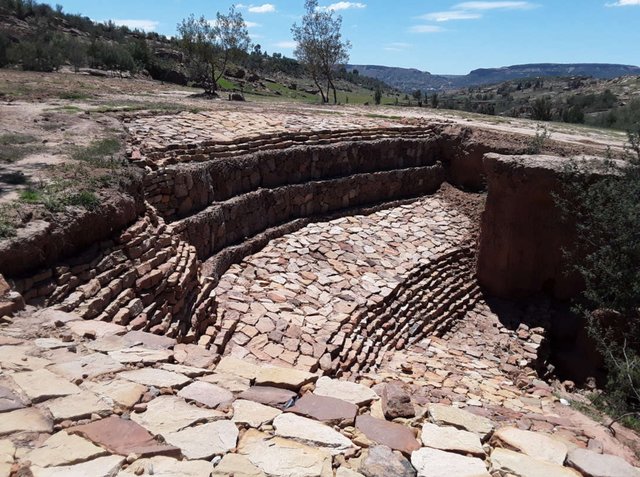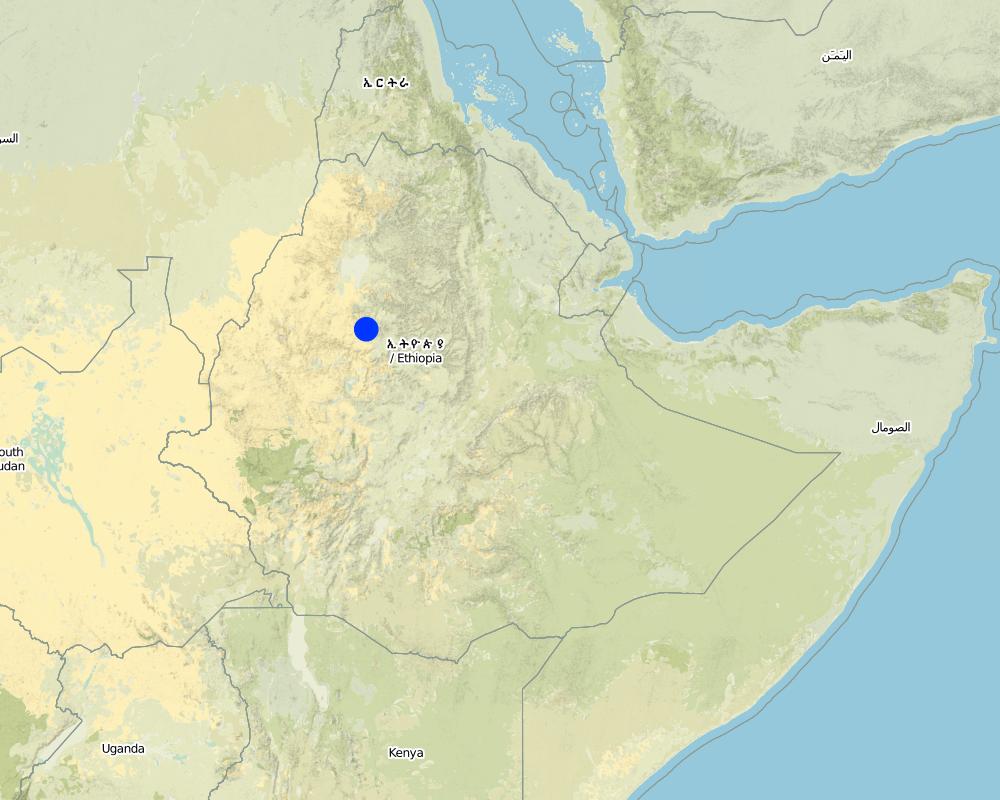Social Infrastructure for Soil Conservation [ប្រទេសអេត្យូពី]
- ការបង្កើត៖
- បច្ចុប្បន្នភាព
- អ្នកចងក្រង៖ Hans Hurni
- អ្នកកែសម្រួល៖ –
- អ្នកត្រួតពិនិត្យ Fabian Ottiger
approaches_2390 - ប្រទេសអេត្យូពី
ពិនិត្យមើលគ្រប់ផ្នែក
ពង្រីកមើលទាំងអស់ បង្រួមទាំងអស់1. ព័ត៌មានទូទៅ
1.2 ព័ត៌មានលម្អិតពីបុគ្គលសំខាន់ៗ និងស្ថាប័នដែលចូលរួមក្នុងការវាយតម្លៃ និងចងក្រងឯកសារនៃវិធីសាស្ត្រផ្សព្វផ្សាយ
ឈ្មោះអង្គភាពមួយ (ច្រើន) ដែលបានចងក្រងឯកសារ/ វាយតម្លៃលើវិធីសាស្ត្រផ្សព្វផ្សាយ (បើទាក់ទង)
CDE Centre for Development and Environment (CDE Centre for Development and Environment) - ប្រទេសស្វ៊ីស1.3 លក្ខខណ្ឌទាក់ទងទៅនឹងការប្រើប្រាស់ទិន្នន័យដែលបានចងក្រងតាមរយៈវ៉ូខេត
អ្នកចងក្រង និង(បុគ្គលសំខាន់ៗ)យល់ព្រមទទួលយកនូវលក្ខខណ្ឌនានាទាក់ទងទៅនឹងការប្រើប្រាស់ទិន្នន័យដែលបានចងក្រងតាមរយៈ វ៉ូខេត:
បាទ/ចា៎
1.4 ការយោងមួយ (ច្រើន) ទៅលើ (កម្រង) បញ្ជីសំណួរនៃបច្ចេកទេស SLM

Gully head structure [ប្រទេសឡេសូតូ]
The aim of the gully head structure is to help stabilise the gully and prevent/control the gully from expanding further in length due to erosion. In Lesotho, this is constructed using stones.
- អ្នកចងក្រង៖ Matoka Moshoeshoe
2. ការពណ៌នាអំពីវិធីសាស្ត្រផ្សព្វផ្សាយ SLM
2.1 ពណ៌នាសង្ខេបខ្លីពីវិធីសាស្ត្រផ្សព្វផ្សាយ
Negotiation with the stakeholder community of a catchment on social incentives to be offered by external agency in exchange of additional inputs by the communty to be invested into soil and water conservation measures.
2.2 ពណ៌នាលម្អិតពិវិធីសាស្ត្រផ្សព្វផ្សាយ
ពណ៌នាលម្អិតពិវិធីសាស្ត្រផ្សព្វផ្សាយ:
Aims / objectives: The overall purposeof the approach is to achieve sustainable land management without direct incentives such as food-for-work, cash payment, etc. Instead, the community is contracted through a negotiation process to invest into conservation without any direct incentives. Instead, the community will be entitled to select a social investment in their territory which conforms to its most pressing needs, e.g. a clinic, a school, a road, etc. Specific objective is to persuade farmers of the virtue of sustainable land management without direct pay, and to show that outside help is tied to this long-term community commitment when investing into social infrastrcuture. In the end, this is a win-win situation because two goals are achieved with a much greater investment and commitment from the farmer side, while sustainable land management and social development are furthered.
2.5 ប្រទេស/តំបន់/ទីតាំងកន្លែង ដែលវិធីសាស្ត្រផ្សព្វផ្សាយត្រូវបានអនុវត្តន៍
ប្រទេស:
ប្រទេសអេត្យូពី
តំបន់/រដ្ឋ/ខេត្ត:
Gojam
Map
×2.6 កាលបរិច្ឆេទនៃការចាប់ផ្តើម និងបញ្ចប់នៃវិធីសាស្រ្តផ្សព្វផ្សាយនេះ
សូមបញ្ជាក់ឆ្នាំដែលបានបង្កើតឡើង:
1985
ឆ្នាំបញ្ចប់ (ប្រសិនបើវិធីសាស្ត្រផ្សព្វផ្សាយត្រូវបានឈប់ប្រើប្រាស់):
1988
2.7 ប្រភេទនៃវិធីសាស្ត្រផ្សព្វផ្សាយ
- ផ្អែកលើគម្រោង/កម្មវិធី
2.8 គោលបំណង/ទិសដៅសំខាន់នៃវិធីសាស្ត្រផ្សព្វផ្សាយ
The Approach focused mainly on SLM with other activities (Area closure / cut & carry of grass. Clinic construction & facilitation.)
There is no document, but the SCRP goal is to support sustainable use of natural resources. In Anjeni this should be achieved through a specific incentive at social level.
The SLM Approach addressed the following problems: Accelerating soil erosion. Declining production of crops. Overland runoff destroying crops and producing gullies. Poor social infrastructure in community.
2.9 លក្ខខណ្ឌអនុញ្ញាត ឬរារាំងការអនុវត្តន៍បច្ចេកទេសដែលស្ថិតនៅក្រោមវិធីសាស្រ្តផ្សព្វផ្សាយ
សង្គម/វប្បធម៌/ និងតម្លៃនៃសាសនា
- រារាំង
lack of community collaboration
Treatment through the SLM Approach: further processes of community development
បរិបទនៃស្ថាប័ន
- រារាំង
lack of trained extensionists
Treatment through the SLM Approach: training supprt
ក្របខណ្ឌច្បាប់ (សិទ្ធិកាន់កាប់ដីធ្លី កម្មសិទ្ធីប្រើប្រាស់ដីនិងទឹក)
- រារាំង
lack of land ownership
Treatment through the SLM Approach: clarify ownership and user rights
The existing land ownership, land use rights / water rights hindered a little the approach implementation But not much. Attitudes of farmers towards investments into their land remain negative.
3. ការចូលរួម និងតួនាទីរបស់ភាគីពាក់ព័ន្ធ
3.1 អ្នកពាក់ព័ន្ធដែលបានចូលរួមក្នុងវិធីសាស្ត្រផ្សព្វផ្សាយ និងតួនាទីរបស់ពួកគេ
- អ្នកប្រើប្រាស់ដីក្នុងតំបន់/សហគមន៍
Groups of users organised through the project; Working land users were mainly men (Some women and children also participated.)
Women were less involved in planning and implementation of SWC, but more with social infrastructure. In Ethiopia, men traditionally do soil labour in field. The approach included all communities including all households.
- រដ្ឋាភិបាលថ្នាក់ជាតិ (អ្នករៀបចំផែនការ អ្នកសម្រេចចិត្ត)
Ministry of Agriculture
Ministry of Health
- អង្គការអន្តរជាតិ
ប្រសិនមានភាគីពាក់ព័ន្ធច្រើនចូលរួមសូមចង្អុលបង្ហាញភ្នាក់ងារដែលនាំមុខគេ:
Expat: Overall principle of conservation for infrastructure approach. Nationals: Design of objectives, activities. Land users: Agreement on approach and specific designs of technology & maintenance.
3.2 ការចូលរួមរបស់អ្នកប្រើប្រាស់ដីក្នុងតំបន់/ សហគមន៍ក្នុងតំបន់ក្នុងដំណាក់កាលផ្សេងគ្នានៃវិធីសាស្រ្តផ្សព្វផ្សាយ
| ការចូលរួមរបស់អ្នកប្រើប្រាស់ដីក្នុងតំបន់/សហគមន៍ក្នុងតំបន់ | សូមបញ្ជាក់នរណាត្រូវបានចូលរួម ព្រមទាំងពណ៌នាសកម្មភាពទាំងនោះ | |
|---|---|---|
| ការចាប់ផ្តើម/ការលើកទឹកចិត្ត | គ្មាន | |
| ការរៀបចំផែនការ | អសកម្ម | interviews/questionnaires |
| ការអនុវត្តន៍ | អសកម្ម | responsibility for major steps |
| ការត្រួតពិនិត្យ និងវាយតម្លៃ | អសកម្ម | public meetings; |
| Research | គ្មាន |
3.4 ការសម្រេចចិត្តលើការជ្រើសរើសបច្ចេកទេស SLM
សូមបញ្ជាក់តើអ្នកណាជាអ្នកបានសម្រេចចិត្តក្នុងការជ្រើសរើសបច្ចេកទេសដើម្បីយកមកអនុវត្តន៍:
- អ្នកជំនាញឯកទេស SLM បន្ទាប់ពីបានប្រឹក្សាយោបល់ជាមួយអ្នកប្រើប្រាស់ដី
ចូរពន្យល់:
consultative. Development of technology was based on existing indigenous technologies which were complemented and perennized. The approach was explained to the farmers, a 10ha demonstration area was established for one year, and the agreement was reached after that time to do it on 100 ha, if social infrastructure support was given.
Decisions on the method of implementing the SLM Technology were made by by SLM specialists alone (top-down). directive (top-down). Proposal by Development Agents was explained to farmers, and their consent used to organize the mass implementation campaign in 1987.
4. ជំនួយបច្ចេកទេស ការកសាងសមត្ថភាព និងការគ្រប់គ្រងចំណេះដឹង
4.1 ការកសាងសមត្ថភាព/ បណ្តុះបណ្តាល
តើវគ្គបណ្តុះបណ្តាលបានផ្តល់ឱ្យអ្នកប្រើប្រាស់ដី/អ្នកពាក់ព័ន្ធផ្សេងៗទៀតដែរឬទេ?
បាទ/ចា៎
សូមបញ្ជាក់តើអ្នកណាត្រូវបានបណ្តុះបណ្តាល:
- អ្នកប្រើប្រាស់ដី
- SWC specialists (2), extensionists/trainers (1), politicians/decision makers (1)
ទម្រង់នៃការបណ្តុះបណ្តាល:
- អនុវត្តន៍ជាមួយការងារ
- ទីតាំងបង្ហាញ
- ការប្រជុំជាសាធារណៈ
ប្រធានបទបណ្តុះបណ្តាល:
Technical design of SWC techniques. Institutions on maintenance & modifications.
4.2 សេវាផ្តល់ប្រឹក្សាយោបល់
តើអ្នកប្រើប្រាស់ដីបានទទួលនូវសេវាផ្តល់ប្រឹក្សាដែរ ឬទេ?
បាទ/ចា៎
សូមបញ្ជាក់ប្រសិនបើសេវាកម្មប្រឹក្សាយោបល់ត្រូវបានផ្តល់ឱ្យ:
- នៅលើដីរបស់អ្នកប្រើប្រាស់ដី
ពណ៌នា/ពន្យល់:
Name of method used for advisory service: Government Extension System.; Key elements: Holding of meetings., Technical layout of SWC techniques., Support in negotiations & follow-up.; 1) Mainly: government's existing extension system, Partly: projects own extension structure and agent; Extension staff: Mainly government employees 2) Target groups for extension: School children/students, Teachers; Activities: Demonstration visits to nearby catchment and preparation of a school b
Advisory service is inadequate to ensure the continuation of land conservation activities; Farmer to extensionist ratio is 1000:1 or worse. Educational status of all is low. Approach of extension still needs improvement.
4.3 ការពង្រឹងសមត្ថភាពស្ថាប័ន (ការអភិរឌ្ឍន៍អង្គភាព)
តើស្ថាប័នទាំងអស់ត្រូវបានបង្កើតឡើង ឬពង្រឹងសមត្ថភាពតាមរយៈវិធីសាស្ត្រផ្សព្វផ្សាយដែរ ឬទេ?
- បាទ/ច៎ា ជាមធ្យម
សូមបញ្ជាក់ថាតើស្ថាប័នត្រូវបានពង្រឹង ឬបង្កើតឡើងនៅត្រឹមកម្រិតណា(ច្រើន)?
- ថ្នាក់មូលដ្ឋាន
សូមបញ្ជាក់ប្រភេទនៃការគាំទ្រ:
- សម្ភារៈ
4.4 ការត្រួតពិនិត្យ និងវាយតម្លៃ
តើការត្រួតពិនិត្យ និងវាយតម្លៃគឺជាផ្នែកមួយនៃវិធីសាស្ត្រដែរឬទេ?
បាទ/ចា៎
មតិយោបល់:
bio-physical aspects were regular monitored through observations
technical aspects were regular monitored through observations
socio-cultural aspects were regular monitored through observations
economic / production aspects were regular monitored through measurements
There were several changes in the Approach as a result of monitoring and evaluation: Technology was adapted according to farmers wishes, namely adjustments of narrow terraces by removing some, overlay of drainage system over terraces and not along them.
Monitoring & extension in still ongoing through SCRP, and since 1984 in Anjeni.
4.5 ការស្រាវជ្រាវ
តើការស្រាវជ្រាវ គឺជាផ្នែកមួយនៃវិធីសាស្រ្តដែរឬទេ?
បាទ/ចា៎
បញ្ជាក់ប្រធានបទ:
- សង្គមវិទ្យា
- សេដ្ឋកិច្ច/ទីផ្សារ
- បរិស្ថានវិទ្យា
- បច្ចេកវិទ្យា
- Land use dynamics, farming system.
សូមផ្តល់ព័ត៌មានបន្ថែមទៀតឱ្យបានលម្អិត និងចង្អុលបង្ហាញនរណាដែលបានធ្វើការស្រាវជ្រាវ:
The treated catchment of Anjeni is part of a research set-up where continuous monitoring and evaluation is being carried out since 1984.
Research was carried out on-farm
5. ថវិកា និងសម្ភារៈឧបត្ថម្ភពីខាងក្រៅ
5.1 ថវិកាប្រចាំឆ្នាំសម្រាប់ផ្សព្វផ្សាយ SLM
ប្រសិនបើចំនួនពិតប្រាកដនៃថវិកាប្រចាំឆ្នាំមិនត្រូវបានដឹងច្បាស់ សូមប្រាប់ពីចន្លោះនៃថវិកានោះ:
- 10,000-100,000
មតិយោបល់ (ឧ. ប្រភពសំខាន់នៃមូលនិធិ/ម្ចាស់ជំនួយចំបង):
Approach costs were met by the following donors: international (GDE/SCRP): 25.0%; government (national - Min. of Agriculture): 5.0%; local community / land user(s) (-): 70.0%
5.2 ការគាំទ្រផ្នែកហិរញ្ញវត្ថុ / សម្ភារៈដែលបានផ្តល់ទៅឱ្យអ្នកប្រើប្រាស់ដី
តើអ្នកប្រើប្រាស់ដីបានទទួលការគាំទ្រផ្នែកហិរញ្ញវត្ថ/សម្ភារៈសម្រាប់ការអនុវត្តន៍បច្ចេកទេសដែរឬទេ:
បាទ/ចា៎
5.3 សូមបញ្ជាក់ពីធាតុចូលត្រូវបានផ្តល់បដិភាគ (រួមទាំងកម្លាំងពលកម្ម)
- សម្ភារៈ
| សូមបញ្ជាក់ ធាតុចូលណាខ្លះដែលបានផ្តល់បដិភាគ | កម្រិតទំហំប៉ុណ្ណា | សូមបញ្ជាក់ពីការបដិភាគ |
|---|---|---|
| ឧបករណ៍ | ផ្តល់ហិរញ្ញវត្ថុទាំងស្រុង | Hand tools |
- ហេដ្ឋារចនាសម្ព័ន្ធ
| សូមបញ្ជាក់ ធាតុចូលណាខ្លះដែលបានផ្តល់បដិភាគ | កម្រិតទំហំប៉ុណ្ណា | សូមបញ្ជាក់ពីការបដិភាគ |
|---|---|---|
| Community infrastructure | ផ្តល់ហិរញ្ញវត្ថុមួយផ្នែក | Support to clinic was 50% of cost of clinic only. |
ប្រសិនបើកម្លាំងពលកម្មធ្វើដោយអ្នកប្រើប្រាស់ដី តើវាជាធាតុចូលដ៏សំខាន់មួយដែរ ឬទេ:
- ដោយស្ម័គ្រចិត្ត
មតិយោបល់:
In exchange of SWC works support to clinic was given as an overall incentive.
5.4 ឥណទាន
តើឥណទានដែលបានផ្តល់នៅក្រោមវិធីសាស្ត្រផ្សព្វផ្សាយសម្រាប់សកម្មភាព SLM នេះយ៉ាងដូចម្តេច?
ទេ
6. ការវិភាគរកផលប៉ះពាល់ និងសេចក្តីសន្និដ្ឋាន
6.1 ផលប៉ះពាល់នៃវិធីសាស្ត្រផ្សព្វផ្សាយ
តើវិធីសាស្ត្រផ្សព្វផ្សាយជួយអ្នកប្រើប្រាស់ដីដើម្បីអនុវត្តន៍ និងថែទាំបច្ចេកទេស SLM?
- ទេ
- បាទ/ច៎ា បន្តិចបន្តួច
- បាទ/ច៎ា ជាមធ្យម
- បាទ/ច៎ា បានខ្លាំង
Traditional soil fertility management was already exhaustively used under the given farming system.
តើវិធីសាស្ត្រផ្សព្វផ្សាយបានឱ្យប្រសើរឡើងនូវបញ្ហាកាន់កាប់ដីធ្លី/សិទ្ធិអ្នកប្រើប្រាស់ដែលរារាំងដល់ការអនុវត្ត SLM?
- ទេ
- បាទ/ច៎ា បន្តិចបន្តួច
- បាទ/ច៎ា ជាមធ្យម
- បាទ/ច៎ា បានខ្លាំង
The problem is unlikely to be overcome in the near future. Present government insists on state ownership of land.
Did other land users / projects adopt the Approach?
- ទេ
- បាទ/ច៎ា បន្តិចបន្តួច
- បាទ/ច៎ា ជាមធ្យម
- បាទ/ច៎ា បានខ្លាំង
A large programme in Merhabete involving 2,000 ha and about 10,000 people adopted a similar system, however with a technology that was suitable to their area (level bunds).
6.3 សកម្មភាពផ្សព្វផ្សាយដែលប្រកបដោយចីរភាព
តើអ្នកប្រើប្រាស់ដីអាចធ្វើឱ្យមានចីរភាពនូវអ្វីដែលត្រូវបានអនុវត្តន៍តាមរយៈវិធីសាស្ត្រផ្សព្វផ្សាយដែរឬទេ(ដោយពុំមានការគាំទ្រពីអ្នកខាងក្រៅ)?
- ទេ
ប្រសិន ទេ ឬមិនប្រាកដសូមបញ្ជាក់ និងពន្យល់:
Social incentives will have to come from outside (government or NGO)
6.4 ភាពខ្លាំង/ គុណសម្បត្តិនៃវិធីសាស្ត្រផ្សព្វផ្សាយ
| ភាពខ្លាំង/ គុណសម្បត្តិ/ ឱកាស ទស្សនៈរបស់អ្នកប្រើប្រាស់ដី |
|---|
| Fulfillment of community needs (How to sustain/ enhance this strength: Co-ordination and participatory approach) |
| All catchment land users do conservation jointly together (How to sustain/ enhance this strength: Community versus individual approach) |
| ភាពខ្លាំង/ គុណសម្បត្តិ/ ឱកាស ទស្សនៈរបស់បុគ្គលសំខាន់ៗ |
|---|
| Negotiation processes (How to sustain/ enhance this strength: Train extensionists) |
| Social incentives (How to sustain/ enhance this strength: Better cooperation between different ministries on their activities as a package) |
6.5 ភាពខ្សោយ/ គុណវិបត្តិនៃវិធីសាស្ត្រ និងរកដំណោះស្រាយ
| ភាពខ្សោយ/ គុណវិបត្តិ/ ហានិភ័យ ទស្សនៈរបស់អ្នកប្រើប្រាស់ដី | តើបច្ចេកទេសទាំងនោះបានដោះស្រាយបញ្ហាដូចម្តេច? |
|---|---|
| Combining two goals necessitates more labour inputs | No solution |
| ភាពខ្សោយ/ គុណវិបត្តិ/ ហានិភ័យក្នុងទស្សនៈរបស់បុគ្គលសំខាន់ៗ | តើបច្ចេកទេសទាំងនោះបានដោះស្រាយបញ្ហាដូចម្តេច? |
|---|---|
| Tieing social investments with soil conservation is politically difficult because two goals are pursued with one instrument | No option but continue |
| Interest may still be initiated basically from need and less from degradation | Awareness needs to be furthered still |
7. ឯកសារយោង និងវេបសាយ
7.1 វិធីសាស្ត្រ/ ប្រភពនៃព័ត៌មាន
- តាមការចុះទីវាល ការស្រាវជ្រាវនៅទីវាល
- ការសម្ភាសន៍ជាមួយអ្នកប្រើប្រាស់ដី
7.2 ឯកសារយោងដែលបានចេញផ្សាយ
ចំណងជើង អ្នកនិពន្ធ ឆ្នាំ ISBN:
SCRP Progress Reports
មានប្រភពមកពីណា? ថ្លៃដើមប៉ុន្មាន?
SCRP, Addis Abeba
ចំណងជើង អ្នកនិពន្ធ ឆ្នាំ ISBN:
Book Learning from Anjeni' (Amharic)'
មានប្រភពមកពីណា? ថ្លៃដើមប៉ុន្មាន?
Min. of Education, Bahr Dar
ចំណងជើង អ្នកនិពន្ធ ឆ្នាំ ISBN:
SCRP Research Reports
មានប្រភពមកពីណា? ថ្លៃដើមប៉ុន្មាន?
SCRP, Addis Abeba
ការតភ្ជាប់ និងម៉ូឌុល
ពង្រីកមើលទាំងអស់ បង្រួមទាំងអស់ការតភ្ជាប់

Gully head structure [ប្រទេសឡេសូតូ]
The aim of the gully head structure is to help stabilise the gully and prevent/control the gully from expanding further in length due to erosion. In Lesotho, this is constructed using stones.
- អ្នកចងក្រង៖ Matoka Moshoeshoe
ម៉ូឌុល
គ្មានម៉ូឌុល


